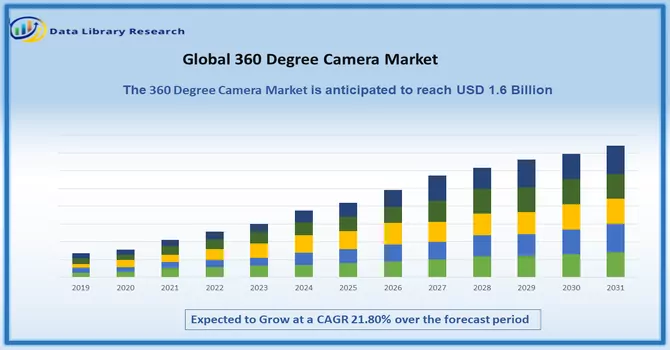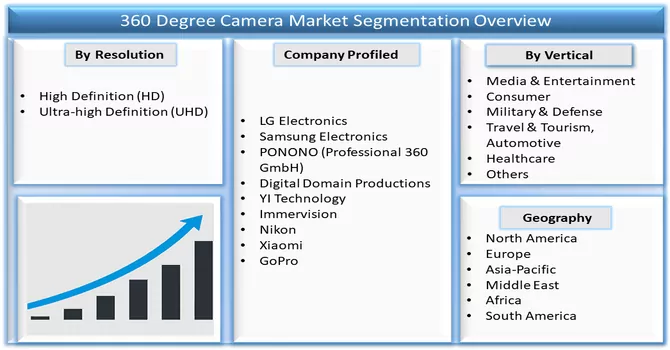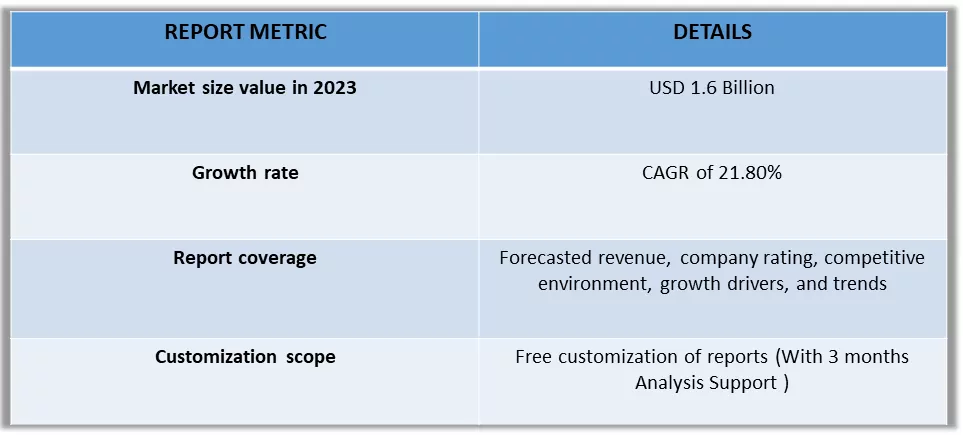The global 360 degree camera market size was estimated at USD 1.6 billion in 2023 and is expected to reach a compound annual growth rate (CAGR) of 21.80% from 2024 to 2031

Get Complete Analysis Of The Report- Download Free Sample PDF
A 360-degree camera, also known as an omnidirectional camera or a panoramic camera, is a device that is capable of capturing a 360-degree field of view in a single shot. These cameras use multiple lenses or a fish-eye lens to capture a complete spherical or cylindrical view of the surroundings. The captured images or videos can be viewed in various ways, including on a computer screen, a virtual reality headset, or a mobile device, allowing viewers to look in any direction as if they were physically present in the scene. 360-degree cameras are commonly used for virtual tours, immersive experiences, and capturing panoramic photos and videos.
The growth of the 360-degree camera market is fueled by increasing demand for virtual reality and augmented reality experiences, expanding use in media and entertainment, rising adoption in surveillance and security, rapid technological advancements, popularization in action cameras, expanding automotive applications, and broader industry adoption. These factors collectively contribute to the market's expansion, driven by the cameras' ability to capture immersive and comprehensive views of environments for a variety of applications.
Market Segmentation: The Global 360 Degree Camera Market is Segmented by Resolution (High Definition (HD) and Ultra-high Definition (UHD)) and By Vertical: Media & Entertainment, Consumer, Military & Defense, Travel & Tourism, Automotive, Commercial, Healthcare, and Others) and and Geography (North America, Europe, Asia-Pacific, Latin America, Middle East & Africa). The market size and forecasts are provided in terms of value (in USD million) for all the above segments.

For Detailed Market Segmentation - Download Free Sample PDF
The market for 360-degree cameras is experiencing several key trends. Firstly, there is a growing demand for these cameras in industries such as real estate, tourism, and e-commerce, driven by the need for immersive and interactive content. Secondly, advancements in technology, such as improved image quality and enhanced connectivity features, are driving the development of more sophisticated 360-degree cameras. Additionally, the increasing popularity of virtual and augmented reality applications is further fueling the demand for these cameras. Finally, the market is witnessing a trend towards more compact and portable 360-degree cameras, making them more accessible to a wider range of consumers. Overall, these trends indicate a promising future for the 360-degree camera market, with opportunities for growth and innovation.
Market Drivers:
Rising Demand for Virtual Reality (VR) and Augmented Reality (AR) Experiences
The increasing popularity of virtual reality (VR) and augmented reality (AR) technologies is revolutionizing various industries, including gaming, entertainment, tourism, and education. These technologies offer immersive experiences that transport users to virtual environments, enhancing their interactions and engagement. 360-degree cameras play a crucial role in this ecosystem by capturing the full range of a scene, allowing viewers to explore and interact with the content from different perspectives. In gaming, for example, 360-degree cameras can capture real-world environments that are then integrated into virtual games, providing a more realistic and immersive experience for players. In the entertainment industry, 360-degree cameras are used to create immersive videos and films that allow viewers to feel like they are part of the action. This is particularly popular in the music industry, where artists use 360-degree cameras to create interactive music videos that provide fans with a unique and engaging experience. In the tourism industry, 360-degree cameras are used to create virtual tours of destinations, allowing people to explore and experience different places from the comfort of their homes. This is especially valuable for travelers who are unable to visit a location in person or want to preview a destination before booking a trip. In education, 360-degree cameras are used to create immersive learning experiences that enhance student engagement and understanding. For example, students can take virtual field trips to historical sites or explore the human body in 360 degrees, providing a more interactive and memorable learning experience. Thus, the increasing popularity of VR and AR technologies is driving the demand for 360-degree cameras, as they are essential for capturing the immersive content that powers these experiences across a wide range of industries.
Growing Adoption in the Media and Entertainment Industry
The media and entertainment industry is at the forefront of utilizing 360-degree cameras to create innovative and engaging content. Platforms like YouTube and Facebook have embraced this technology, allowing users to experience videos in a more immersive way. 360-degree cameras enable content creators to capture a full spherical view of their surroundings, offering viewers a more interactive and engaging experience. This technology has revolutionized storytelling, enabling filmmakers and videographers to create immersive narratives that place viewers in the center of the action. In the entertainment industry, 360-degree cameras are being used to create interactive music videos, live performances, and behind-the-scenes footage. This allows fans to feel like they are part of the experience, enhancing their connection with their favorite artists. In addition to entertainment, 360-degree cameras are also being used in journalism to provide a more immersive and engaging way to report news stories. Journalists can capture 360-degree footage of events, allowing viewers to explore the scene from different angles and gain a more comprehensive understanding of the story. Overall, the media and entertainment industry's adoption of 360-degree cameras is driving the demand for these devices. As the technology continues to evolve, we can expect to see even more innovative and engaging content being created using 360-degree cameras across a variety of platforms and industries.
Market Restraints:
High Cost
The cost of 360-degree cameras, particularly those with advanced features and capabilities, can indeed be a significant barrier to entry for many consumers and businesses. These high costs stem from the sophisticated technology required to capture and process 360-degree footage, as well as the relatively niche market for these cameras. For consumers, the price of a high-quality 360-degree camera can be prohibitive, especially when compared to traditional cameras or smartphones that offer standard video recording capabilities. Similarly, for businesses looking to adopt 360-degree technology for marketing, training, or other purposes, the cost of purchasing and maintaining these cameras can be a deterrent. Additionally, the cost of accessories and software needed to fully utilize 360-degree cameras, such as editing software and compatible viewing devices, can further add to the overall expense.Thus, the high cost of 360-degree cameras can limit their adoption among consumers and businesses, particularly those with budget constraints or who may not see an immediate return on investment. Addressing this barrier will be key to expanding the market for 360-degree cameras and making this technology more accessible to a wider audience.
The COVID-19 pandemic has had a mixed impact on the market for 360-degree cameras. While the initial disruption in supply chains and manufacturing led to some delays in product launches and availability, the increased demand for remote collaboration and virtual experiences has created new opportunities for these cameras. Businesses and individuals are increasingly using 360-degree cameras for virtual meetings, events, and tours, as well as for creating immersive content for online platforms. This shift towards virtual experiences is likely to continue even as the pandemic subsides, driving further growth in the market for 360-degree cameras.
Segmental Analysis:
Ultra-high Definition (UHD) Segment is Expected to Witness Significant Growth Over the Forecast Period
The market for Ultra-high Definition (UHD) and 360-degree cameras is experiencing significant growth driven by the increasing demand for high-quality video content and immersive experiences. UHD cameras, also known as 4K cameras, offer superior image quality and clarity compared to traditional cameras, making them ideal for capturing detailed and realistic footage. On the other hand, 360-degree cameras capture a complete spherical view of the surroundings, allowing viewers to experience a scene from all angles. This technology is being used across various industries, including media and entertainment, tourism, real estate, and education, to create immersive and interactive content. The combination of UHD and 360-degree technology is particularly powerful, as it allows for the creation of high-quality, immersive content that provides viewers with a truly engaging experience. This has led to the increasing adoption of these cameras in industries such as virtual reality (VR), augmented reality (AR), gaming, live events, and online streaming. As the demand for high-quality video content continues to grow, fueled by advancements in technology and the increasing popularity of VR and AR applications, the market for UHD and 360-degree cameras is expected to expand further. However, challenges such as high costs, technical complexity, and limited content distribution platforms may hinder the market's growth to some extent.
Media and Entertainment Segment is Expected to Witness Significant Growth Over the Forecast Period
In the media and entertainment industry, 360-degree cameras have fundamentally changed the way content is created and consumed. These cameras capture a complete spherical view of the surroundings, enabling viewers to immerse themselves in the scene and explore it from different angles. This technology has revolutionized storytelling, allowing filmmakers, musicians, and content creators to offer audiences a more interactive and engaging experience. In filmmaking, 360-degree cameras are used to create immersive narratives that transport viewers into the heart of the story. Directors and cinematographers can capture scenes in a way that makes viewers feel like they are part of the action, enhancing the overall cinematic experience. Similarly, in the music industry, artists are using 360-degree cameras to create interactive music videos that allow fans to experience their favorite songs in a whole new way. Live events and sports broadcasting have also been transformed by 360-degree cameras, with audiences now able to experience concerts, sports games, and other events as if they were there in person. This technology has been particularly impactful in virtual reality (VR) applications, where viewers can use VR headsets to immerse themselves in the event and feel like they are in the front row. In journalism, 360-degree cameras are being used to provide a more immersive and comprehensive view of news stories. Journalists can capture 360-degree footage of events, allowing viewers to explore the scene from different angles and gain a deeper understanding of the story. Overall, the use of 360-degree cameras in the media and entertainment industry has opened up a world of possibilities for content creators and audiences alike. By offering a more immersive and interactive experience, 360-degree cameras are shaping the future of storytelling and content consumption.
North America Region is Expected to Witness Significant Growth Over the Forecast Period
In North America, the use of 360-degree cameras has rapidly expanded across industries such as media, entertainment, real estate, tourism, and education. Filmmakers and content creators are leveraging these cameras to produce immersive narratives and engaging experiences, while real estate professionals are using them to create virtual property tours. In the tourism sector, 360-degree cameras are transforming how destinations are showcased, offering travelers interactive previews. Additionally, schools and universities are adopting these cameras to create immersive learning experiences, indicating a broad acceptance and integration of 360-degree technology across North America.

Get Complete Analysis Of The Report- Download Free Sample PDF
The analyzed market exhibits a high degree of fragmentation, primarily attributable to the presence of numerous players operating on both a global and regional scale. The competitive landscape is characterized by a diverse array of companies, each contributing to the overall market dynamics. This fragmentation arises from the existence of specialized solution providers, established industry players, and emerging entrants, all vying for market share. The diversity in market participants is underscored by the adoption of various strategies aimed at expanding the company presence. On a global scale, companies within the studied market are strategically positioning themselves through aggressive expansion initiatives. This often involves entering new geographical regions, targeting untapped markets, and establishing a robust global footprint. The pursuit of global expansion is driven by the recognition of diverse market opportunities and the desire to capitalize on emerging trends and demands across different regions. Simultaneously, at the regional level, companies are tailoring their approaches to align with local market dynamics. Regional players are leveraging their understanding of specific market nuances, regulatory environments, and consumer preferences to gain a competitive edge. This regional focus allows companies to cater to the unique needs of local clientele, fostering stronger market penetration. To navigate the complexities of the fragmented market, companies are implementing a range of strategies. These strategies include investments in research and development to stay at the forefront of technological advancements, mergers and acquisitions to consolidate market share, strategic partnerships for synergies, and innovation to differentiate products and services. The adoption of such multifaceted strategies reflects the competitive nature of the market, with participants continually seeking avenues for growth and sustainability. In essence, the high fragmentation in the studied market not only signifies the diversity of players but also underscores the dynamism and competitiveness that drive ongoing strategic maneuvers. As companies explore various avenues for expansion, the market continues to evolve, presenting both challenges and opportunities for industry stakeholders.
Some of the prominent players in the global 360 degree camera market include:
Recent Development:
1) In 2023: GoPro introduced the Hero 12 Black action camera with features such as an 8:7 aspect ratio sensor, vertical video capability, HDR support, and compatibility with Bluetooth mics. Many of these features in the Hero 12 Black were informed by insights into markets like India, as stated by PABLO LEMA, Vice President of Product Management at GoPro, in an email interview with Khalid Anzar. These innovative features were aimed at driving the growth of the 360-degree camera market. The 8:7 aspect ratio sensor and vertical video support were particularly appealing for social media content creators, enabling them to easily create and share immersive content. The inclusion of HDR enhanced the overall image quality, making the footage more vibrant and engaging. Additionally, the support for Bluetooth mics enhanced the audio recording capabilities, further improving the overall content creation experience.
2) In June 2023, Insta 360's launched Insta360 Go 3, the world's smallest action camera. This device, is set to significantly impact the 360-degree camera market. With its compact size, lightweight design, and high-resolution video capabilities, the Insta360 Go 3 offers unparalleled portability and versatility, catering to a wide range of users and applications. Such product launches is expected to drive the growth of the studied market.
Q1. What was the 360 Degree Camera Market size in 2023?
As per Data Library Research the global 360 degree camera market size was estimated at USD 1.6 billion in 2023.
Q2. At what CAGR is the market projected to grow within the forecast period?
360 Degree Camera Market is expected to reach a compound annual growth rate (CAGR) of 21.80%.
Q3. Which region has the largest share of the 360 Degree Camera market? What are the largest region's market size and growth rate?
North America has the largest share of the market. For detailed insights on the largest region's market size and growth rate request a sample here.
Q4. Who are the key players in 360 Degree Camera market?
Some key players operating in the market include
Data Library Research are conducted by industry experts who offer insight on industry structure, market segmentations technology assessment and competitive landscape (CL), and penetration, as well as on emerging trends. Their analysis is based on primary interviews (~ 80%) and secondary research (~ 20%) as well as years of professional expertise in their respective industries. Adding to this, by analysing historical trends and current market positions, our analysts predict where the market will be headed for the next five years. Furthermore, the varying trends of segment & categories geographically presented are also studied and the estimated based on the primary & secondary research.
In this particular report from the supply side Data Library Research has conducted primary surveys (interviews) with the key level executives (VP, CEO’s, Marketing Director, Business Development Manager and SOFT) of the companies that active & prominent as well as the midsized organization
FIGURE 1: DLR RESEARH PROCESS

Extensive primary research was conducted to gain a deeper insight of the market and industry performance. The analysis is based on both primary and secondary research as well as years of professional expertise in the respective industries.
In addition to analysing current and historical trends, our analysts predict where the market is headed over the next five years.
It varies by segment for these categories geographically presented in the list of market tables. Speaking about this particular report we have conducted primary surveys (interviews) with the key level executives (VP, CEO’s, Marketing Director, Business Development Manager and many more) of the major players active in the market.
Secondary ResearchSecondary research was mainly used to collect and identify information useful for the extensive, technical, market-oriented, and Friend’s study of the Global Extra Neutral Alcohol. It was also used to obtain key information about major players, market classification and segmentation according to the industry trends, geographical markets, and developments related to the market and technology perspectives. For this study, analysts have gathered information from various credible sources, such as annual reports, sec filings, journals, white papers, SOFT presentations, and company web sites.
Market Size EstimationBoth, top-down and bottom-up approaches were used to estimate and validate the size of the Global market and to estimate the size of various other dependent submarkets in the overall Extra Neutral Alcohol. The key players in the market were identified through secondary research and their market contributions in the respective geographies were determined through primary and secondary research.
Forecast Model
